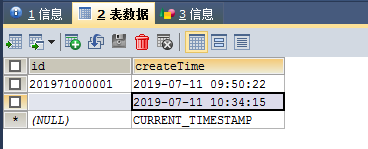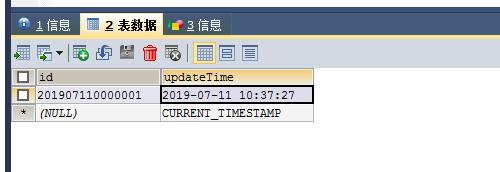How to solve the problem of Mysql using on update current_timestamp
Mysql uses on update current_timestamp. Notes
In recent projects, the time field (datetime, timestamp) has used the ON UPDATE CURRENT_TIMESTAMP attribute to automatically update the column timestamp. . The following records some points that need attention.
Let’s talk about the conclusion first
If you set the time to update with the current timestamp (ON UPDATE CURRENT_TIMESTAMP), then when you update the field, only the field value changes, your time field will be It will change to the time during UPDATE operation.
That is, when there is no field update, although the update statement is executed successfully, the time field will not be updated.
For example, we create a new table:
CREATE TABLE `t_temp` ( `id` int(11) NOT NULL DEFAULT '0', `username` varchar(255) DEFAULT NULL, `upd_time` timestamp NULL DEFAULT CURRENT_TIMESTAMP ON UPDATE CURRENT_TIMESTAMP COMMENT '默认取当前时间', PRIMARY KEY (`id`) ) ENGINE=InnoDB DEFAULT CHARSET=utf8;
Then insert a row of data, and then perform an update.

UPDATE t_temp SET username = 'mm' WHERE id = 1;
You will find that the time column will not be updated.
Similarly, some frameworks are used in the program, such as tk-mybatis. When using the update method (such as int updateByPrimaryKeySelective(T record); method), if the field is not actually updated, although the syntax is executed, the time field It will not be updated, which is easy to overlook in the system.
CURRENT_TIMESTAMP() is related to ON UPDATE and index
Basic probability
CURRENT_TIMESTAMP() can set the TIMESTAMP type in MYSQL to the current time.
ON UPDATE personally thinks this is an artifact. It is generally used when a certain field is updateTIme and the last modified time is used. Just use this ON UPDATE. In this way, developers do not have to handle it themselves, MySQL can handle it automatically.
Finally, let’s talk about the index. This one comes from Baidu. I forgot who it is from: the index is a special file (the index on the InnoDB data table is a component of the table space) , they contain reference pointers to all records in the data table.
It can be said that a database index is like the table of contents of a book, which can increase the speed of database queries. Indexes are divided into clustered indexes and non-clustered indexes. Clustered indexes are ordered according to the physical location of data storage, but non-clustered indexes are different; clustered indexes can increase the speed of multi-row retrieval, while Non-clustered indexes are fast for retrieval of single rows.
If you create too many indexes, it will have an impact on the speed of update and insert operations, because each index file needs to be updated. For a table that frequently needs to be updated and inserted, there is no need to create a separate index for a rarely used where clause. For smaller tables, the sorting overhead will not be very large, and there is no need to create additional indexes.
Code and Example
The table creation code is as follows:
CREATE TABLE timeDemo( id VARCHAR(64) NOT NULL, timeTest TIMESTAMP NOT NULL, PRIMARY KEY (id) );
When adding a new data:

He will automatically create a time, such as an order table, and if he wants to record the time when an order is placed, he can use this method to process it.
Including updateTime, the last update time:
CREATE TABLE timeDemo2( id VARCHAR(64) NOT NULL, createTime TIMESTAMP NOT NULL DEFAULT CURRENT_TIMESTAMP(), updateTime TIMESTAMP NOT NULL DEFAULT CURRENT_TIMESTAMP() ON UPDATE CURRENT_TIMESTAMP(), PRIMARY KEY (id) );
//The above version of mysql5.7 or above will not have problems, but the version below 5.7 will have problems
// For versions below 5.7, it is recommended to use a program to insert.
Here we use 5.5 to demonstrate the effect of ON UPDATE
CREATE TABLE timeDemo3( id VARCHAR(64) NOT NULL, updateTime TIMESTAMP NOT NULL DEFAULT CURRENT_TIMESTAMP() ON UPDATE CURRENT_TIMESTAMP(), PRIMARY KEY (id) );
When some data in this table is modified, the value of updateTime will be automatically updated.

#Every time this record is updated, updateTime will be updated automatically. In this case, the programmer does not need to handle it himself.
It can be found here that unfortunately many Internet companies like to use MySQL5.7 or above, while traditional industries still use MySQL5.5 version.
Let’s talk about index key and index
CREATE TABLE timeDemo4( id VARCHAR(64) NOT NULL, id2 VARCHAR(64) NOT NULL, updateTime TIMESTAMP NOT NULL DEFAULT CURRENT_TIMESTAMP() ON UPDATE CURRENT_TIMESTAMP(), PRIMARY KEY (id), KEY(id2) )ENGINE=INNODB DEFAULT CHARSET=utf8
The only purpose of ordinary index is to improve the speed of data access. This kind of index is defined by the keyword KEY or INDEX. Therefore, indexes should only be created for those data columns that appear most frequently in query conditions (WHERE column = ...) or sorting conditions (ORDER BY column).
In order to create an index, you should choose the most regular and compact data column, such as an integer type data column, whenever possible.
The above is the detailed content of How to solve the problem of Mysql using on update current_timestamp. For more information, please follow other related articles on the PHP Chinese website!

Hot AI Tools

Undresser.AI Undress
AI-powered app for creating realistic nude photos

AI Clothes Remover
Online AI tool for removing clothes from photos.

Undress AI Tool
Undress images for free

Clothoff.io
AI clothes remover

AI Hentai Generator
Generate AI Hentai for free.

Hot Article

Hot Tools

Notepad++7.3.1
Easy-to-use and free code editor

SublimeText3 Chinese version
Chinese version, very easy to use

Zend Studio 13.0.1
Powerful PHP integrated development environment

Dreamweaver CS6
Visual web development tools

SublimeText3 Mac version
God-level code editing software (SublimeText3)

Hot Topics
 1386
1386
 52
52
 MySQL: Simple Concepts for Easy Learning
Apr 10, 2025 am 09:29 AM
MySQL: Simple Concepts for Easy Learning
Apr 10, 2025 am 09:29 AM
MySQL is an open source relational database management system. 1) Create database and tables: Use the CREATEDATABASE and CREATETABLE commands. 2) Basic operations: INSERT, UPDATE, DELETE and SELECT. 3) Advanced operations: JOIN, subquery and transaction processing. 4) Debugging skills: Check syntax, data type and permissions. 5) Optimization suggestions: Use indexes, avoid SELECT* and use transactions.
 How to open phpmyadmin
Apr 10, 2025 pm 10:51 PM
How to open phpmyadmin
Apr 10, 2025 pm 10:51 PM
You can open phpMyAdmin through the following steps: 1. Log in to the website control panel; 2. Find and click the phpMyAdmin icon; 3. Enter MySQL credentials; 4. Click "Login".
 MySQL: An Introduction to the World's Most Popular Database
Apr 12, 2025 am 12:18 AM
MySQL: An Introduction to the World's Most Popular Database
Apr 12, 2025 am 12:18 AM
MySQL is an open source relational database management system, mainly used to store and retrieve data quickly and reliably. Its working principle includes client requests, query resolution, execution of queries and return results. Examples of usage include creating tables, inserting and querying data, and advanced features such as JOIN operations. Common errors involve SQL syntax, data types, and permissions, and optimization suggestions include the use of indexes, optimized queries, and partitioning of tables.
 Why Use MySQL? Benefits and Advantages
Apr 12, 2025 am 12:17 AM
Why Use MySQL? Benefits and Advantages
Apr 12, 2025 am 12:17 AM
MySQL is chosen for its performance, reliability, ease of use, and community support. 1.MySQL provides efficient data storage and retrieval functions, supporting multiple data types and advanced query operations. 2. Adopt client-server architecture and multiple storage engines to support transaction and query optimization. 3. Easy to use, supports a variety of operating systems and programming languages. 4. Have strong community support and provide rich resources and solutions.
 How to use single threaded redis
Apr 10, 2025 pm 07:12 PM
How to use single threaded redis
Apr 10, 2025 pm 07:12 PM
Redis uses a single threaded architecture to provide high performance, simplicity, and consistency. It utilizes I/O multiplexing, event loops, non-blocking I/O, and shared memory to improve concurrency, but with limitations of concurrency limitations, single point of failure, and unsuitable for write-intensive workloads.
 MySQL and SQL: Essential Skills for Developers
Apr 10, 2025 am 09:30 AM
MySQL and SQL: Essential Skills for Developers
Apr 10, 2025 am 09:30 AM
MySQL and SQL are essential skills for developers. 1.MySQL is an open source relational database management system, and SQL is the standard language used to manage and operate databases. 2.MySQL supports multiple storage engines through efficient data storage and retrieval functions, and SQL completes complex data operations through simple statements. 3. Examples of usage include basic queries and advanced queries, such as filtering and sorting by condition. 4. Common errors include syntax errors and performance issues, which can be optimized by checking SQL statements and using EXPLAIN commands. 5. Performance optimization techniques include using indexes, avoiding full table scanning, optimizing JOIN operations and improving code readability.
 MySQL's Place: Databases and Programming
Apr 13, 2025 am 12:18 AM
MySQL's Place: Databases and Programming
Apr 13, 2025 am 12:18 AM
MySQL's position in databases and programming is very important. It is an open source relational database management system that is widely used in various application scenarios. 1) MySQL provides efficient data storage, organization and retrieval functions, supporting Web, mobile and enterprise-level systems. 2) It uses a client-server architecture, supports multiple storage engines and index optimization. 3) Basic usages include creating tables and inserting data, and advanced usages involve multi-table JOINs and complex queries. 4) Frequently asked questions such as SQL syntax errors and performance issues can be debugged through the EXPLAIN command and slow query log. 5) Performance optimization methods include rational use of indexes, optimized query and use of caches. Best practices include using transactions and PreparedStatemen
 Monitor Redis Droplet with Redis Exporter Service
Apr 10, 2025 pm 01:36 PM
Monitor Redis Droplet with Redis Exporter Service
Apr 10, 2025 pm 01:36 PM
Effective monitoring of Redis databases is critical to maintaining optimal performance, identifying potential bottlenecks, and ensuring overall system reliability. Redis Exporter Service is a powerful utility designed to monitor Redis databases using Prometheus. This tutorial will guide you through the complete setup and configuration of Redis Exporter Service, ensuring you seamlessly build monitoring solutions. By studying this tutorial, you will achieve fully operational monitoring settings




